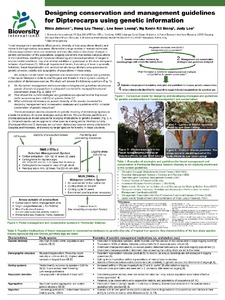planes de ordenación forestal
AGROVOC URI:
Desentralisasi dan tata kelola hutan di Asia dan Pasifik: kecenderungan, pelajaran dan tantangan
Desentralisasi pengelolaan hutan di Bolivia: siapa yang memperoleh manfaat dan mengapa
THE COMPENSATORY AFFORESTATION FUND BILL, 2016
THE COMPENSATORY AFFORESTATION FUND BILL, 2016 A BILL to provide for the establishment of funds under the public accounts of India and the public accounts of each State and crediting thereto the monies received from the user agencies towards compensatory afforestation, additional compensatory afforestation, penal compensatory afforestation, net present value and all other amounts recovered from such agencies under the Forest (Conservation) Act, 1980; constitution of an authority at national level and at each of the State and Union territory Administration for administrati
Developing criteria and indicators of community managed forests as assessment and learning tools: objectives, methodologies and results
This report explores criteria and indicators (C&I) for monitoring and assessing the sustainability of community managed forests (CMFs), and offers some insights into methodological tools and conceptual approaches for C&I development. The research was intended to explore the potential value of C&I to forest communities, their partners and their representative organisations to legitimise and enhance management, including strengthening of control over forest resources and facilitating the equitable distribution of the costs and benefits of forest management.
Devolution in natural resource management: institutional arrangements and power shifts: a synthesis of case studies from southern Africa
The study provides a comparative analysis of the devolution and empowerment process in 14 case studies drawn from eight countries in southern Africa. Each case study examined the extent to which policy and legislation devolves significant control over decision making and benefit flows to communities; the legitimacy and power of different community institutions and their relationship with other stakeholders such as local authority structures, NGOs, donor agencies, and the private sector; and lastly the relationship and divisions between different actors and groupings in the community.
Domesticating forests: how farmers manage forest resources
Local people in South-east Asia are often cited as skilled forest managers. It is barely acknowledged that an essential part of this forest management does not concern natural forests, but forests that have been planted, often after the removal of pre-existing natural forests; forests that are cultivated not by professional foresters, but by sedentary or swidden farmers, on their farmlands; forests that are based not on exotic, fast-growing trees, but on local tree species, and harbour an incredible variety of plant and animal species.
El papel de las instituciones informales en el uso de los recursos forestales en América Latina
This study adopts an institutional approach to analyze the way in which informal rules, in their interaction with formal rules, shape the use of forest resources by diverse types of smallholders and communities (i.e., indigenous people, agro-extractive and traditional communities) in Latin America. Attention is given to understanding the ‘working rules’, comprising both formal and informal rules, that individuals use in making their decisions for land and forest resources access and use, which in turn affect benefits generation and distribution from such resources use.
Emerging REDD+: a preliminary survey of demonstration and readiness activities
This paper presents the results of a preliminary survey of emerging demonstration and readiness activities to reducing emissions from deforestation and forest degradation and carbon stock enhancement (REDD+) across Africa, Asia, and Latin America. The survey was conducted between November and December 2008, and the information collected was updated until May 2009. While the results of the survey offer a useful snapshot of the landscape of REDD+ activities, they do not capture all the dynamics associated with this rapidly evolving field.


